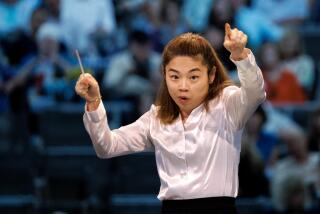MUSIC REVIEW : L.A. Master Chorale Closes Season
Originally scheduled for May 2 but postponed because of the riots, the final program of the Los Angeles Master Chorale season took place Sunday at the Dorothy Chandler Pavilion.
The concert also marked the end of Paul Salamunovichâs first year as music director, and the audience and singers registered their strong approval at the end of a long and demanding program.
Salamunovich conducted a core of about 35 singers in the a cappella first half, with composers ranging from Byrd to Victoria. (After a short speech from the stage, he added to the printed program Victoriaâs âAve Mariaâ as a tribute to chorale founder Roger Wagner, who, he said, was in the hospital.)
After intermission, the full 120-voice chorale, with some members and contingents of brass players placed at the sides of the first balcony, sang antiphonal music by Gabrieli and Palestrina.
Then the full forces joined on stage for other Renaissance music, venturing a lusty âJubilate Deoâ by Gabrieli to close the program.
The small chorus adapted readily to the differing stylistic demands of Dufay, Des Prez, Tallis, Byrd and other Renaissance composers, gently floating polyphonic lines, singing with clean diction but sometimes sounding thin in the middle and strained at the top.
Their best marriage of sound and sense perhaps occurred in the Benedictus of Palestrinaâs Missa Brevis of 1570.
The full chorale sang with sensitivity, strength and wide dynamic range, evoking myriad colors and creating a feeling of solid, towering architecture, especially in Gabrieliâs Magnificat.
But a few quibbles: The predominantly religious programming led to a kind of unsettling thematic recycling. In the second half alone, we went from a scene at the Cross (Palestrinaâs Stabat Mater) and a lament for the slain Christ (Victoriaâs âVictimae Paschali Laudesâ) to the Resurrection (Clemens non Papaâs âAscendens Christusâ) and then back again to the Crucifixion (Antonio Lottiâs âCrucifixusâ). A straighter emotional line would have been preferable.
Also, when Salamunovich ventured into secular repertory, he led it with the same earnestness he devoted to the religious works. Luca Marenzioâs humorous madrigal âContava la Piu Pastorella,â for instance, with its portrayal of a dizzy-headed man unable to decide between the charms of two women, evoked no humor or wit from him. It isnât that serious a piece.
More to Read
The biggest entertainment stories
Get our big stories about Hollywood, film, television, music, arts, culture and more right in your inbox as soon as they publish.
You may occasionally receive promotional content from the Los Angeles Times.










